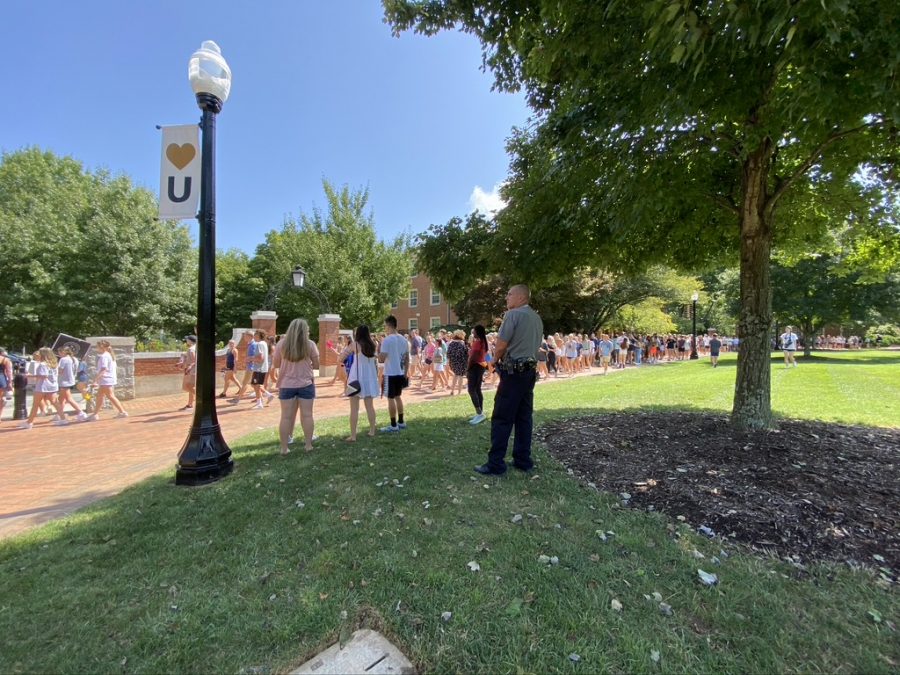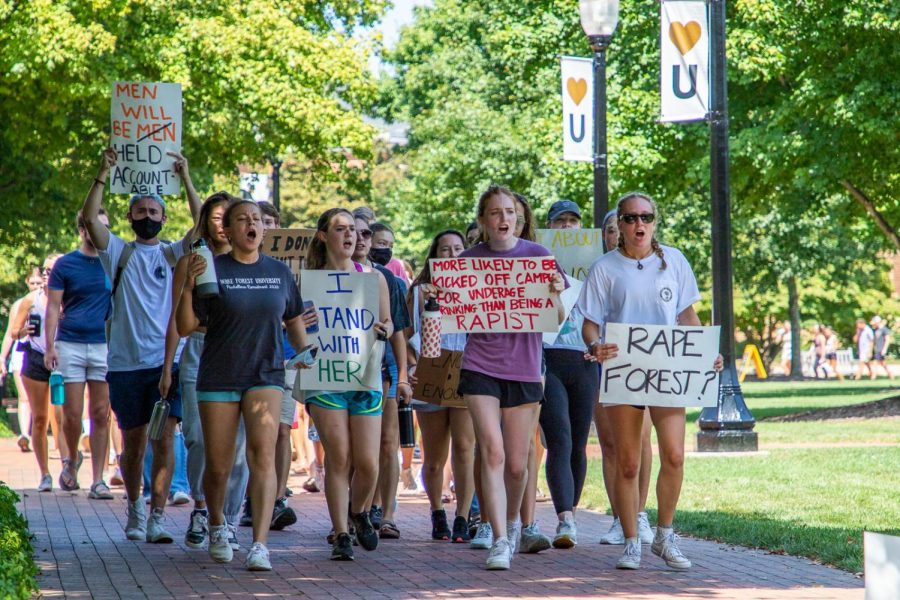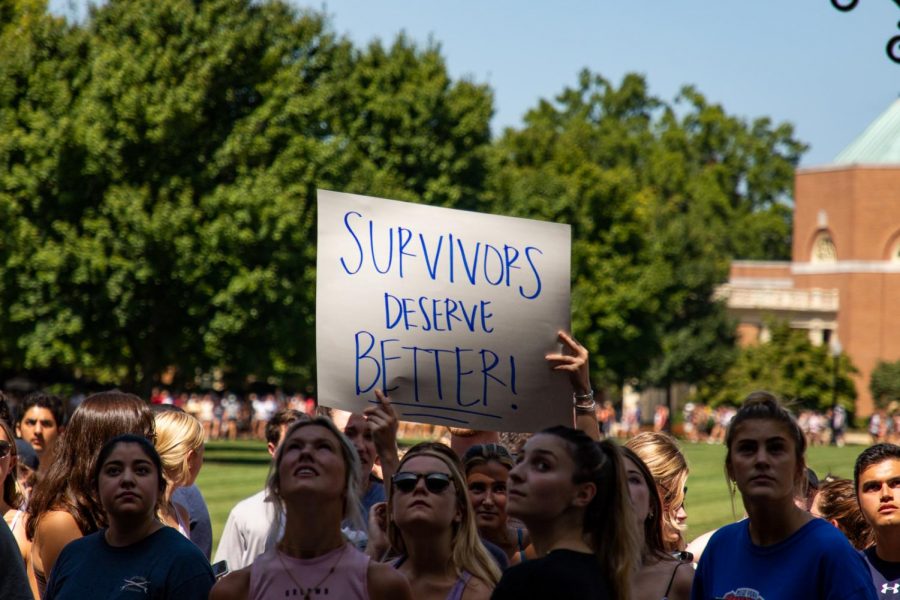Protesters walk to the quad to continue the protest.
Difficult Realities: Wake Forest grapples with sexual, racial violence
September 2, 2021
Wake Forest is still grappling with the aftermath of Saturday’s protest, read the Old Gold & Black’s coverage below.
On August 28, hundreds of students marched around Hearn Plaza demanding accountability from university administrators. We covered the protest and its fallout extensively in the spring semester.
“Keep our forest safe:” protest draws hundreds
Over 300 students gathered at Poteat Residence Hall today at noon in protest against the readmission of a student accused of assaulting another Wake Forest student in 2019.
Some protestors wrote messages in chalk across the concrete in the courtyard. “Hold rapists accountable,” read one. Outside the student’s dorm room, someone had scrawled: “Kick him (back) out.”
The protest follows a public Snapchat story posted by the female student who made the allegation. According to the post, she filed a complaint with the Title IX office in 2019. Her post claims that she was not informed by the administration of the other student’s return to campus. On Friday, she withdrew from Wake, saying she “feels unsafe here and does not want to fight the school for the right to a safe education anymore,” the post said.
At this time, the Old Gold & Black can find no public record to confirm the allegation of sexual assault against the student.
For this reason, OGB has chosen not to name him.
Hours after the Snapchat story was posted, multiple posts calling for a public protest surfaced on Yik Yak, a social media platform that allows members within a five-mile radius of one another to post anonymously. The protest time and location was conceived by sophomore Elizabeth Langshur.
“We obviously want the school to get rid of him,” said Langshur. “All we want is for the administration to keep us safe. There has been no recognition that he has returned.”
The OGB Editorial team reached out and made contact with the re-admitted student, but upon exchanging initial messages with him, have not yet heard back to schedule an interview.
Residence Life and Housing (RLH) Dean Matthew Clifford spoke to the Old Gold & Black about RLH’s responsibility in keeping students safe.
“We work closely with the Title IX office if a student is found responsible in order to navigate outcomes from that particular case,” Clifford said. “Or, if in consultation with University Police and Title IX, there is information… of a threat to the residential environment, then we have an obligation to inform students.”
The protest
Students peered over the balconies of Poteat both to observe and participate in a mass protest that began at noon in the residence hall’s courtyard. After a brief period of chants, including “hey hey, ho ho, rapists here have got to go” and “kick him out”, the students began a march onto Hearn Plaza in a column which took up around three-fourths of the circular path around the quad.
Members of Greek life organizations gathered in support of the protest. Students carried signs with various messages that read: “Rape Forest?” and “Keep Our Forest Safe”.
“This is a complete contradiction of Pro Humanitate,” said junior Grace Powell, a sister in Kappa Delta. “Instead of supporting women, they are supporting financial status.”
“As a member of a proud sisterhood of women, we need to make sure that all women’s voices are heard,” said junior Lexi O’Rourke, who is also in Kappa Delta.
The Inter-Fraternity Council also adjourned their meeting today so that members could attend. Additionally, some fraternity-organized day parties (darties) planned for the same time period were postponed so prospective partygoers could attend the protest.
“I think [this situation is] appalling, but the fact that we could come together so quickly was inspiring,” said junior Charlie Bardenheuer, a member of Theta Chi. “There’s no reason why this man should be part of this school.”
As the protest returned to Poteat, students filed into the courtyard and packed the area of assembly until many were left to stand on the street and sidewalk. A cry of “It’s already hot, let’s make it hotter!” — a reference to putting pressure on the administration — rose up from the center of the crowd.
The conclusion of the protest consisted of a short speech, given by Langshur and senior Maya Dalton.
“There’s still so much to be done here,” Langshur said. “We need to hold Wake Forest accountable.”
“We want responses from our administration,” Dalton said. “Talk about this, talk about it in your classes on Monday, talk about it with your professors, friends, family members, talk about it with everyone. We are not going to be quiet about this because silence is compliance.”
Student Body President Ally Swartzberg expressed support for those in protest.
“Attending class, walking the quad and living in a residence hall without fear are not privileges — they are rights owed to all students enrolled at this University,” Swartzberg’s statement said. “Anything short of protecting these rights for survivors is a failure of the Wake Forest community.”
Organization of the protest
The protest planning moved from Yik Yak to a GroupMe chat around 10:37pm on Friday night, which as of this writing has over 500 members. Members of the chat also drafted a Change.org petition that calls for the Office of Title IX and the Dean of Students to “rectify their decision of jeopardizing the safety of their students.” The petition currently has over 2,900 signatures.
“Each day known assaulters are permitted on campus provides another opportunity for future sexual violence to occur,” the petition reads. “By enabling these individuals to return, the university is complicit in these traumatic acts. When an act of violence like this occurs, these survivor’s lives are forever changed. Never will they feel comfortable walking alone, night or day, never will they have the same access to safe spaces, and a part of their identity is lost forever.”
Administration’s response
Administrators came to the protest after Residence Life and Housing Dean Matt Clifford, Dean of Students Adam Goldstein and Associate Dean for Student Engagement Tim Wilkinson held a meeting in the Subway in Davis.
While still outside of Subway, Goldstein told the Old Gold & Black, that he supports students’ rights to free expression and that his primary concern is with the safety of all of the students involved. “I understand that the students are exercising their voice about this and that’s important. We want students to be active on their issues.”
Goldstein continued “And if students want to know if we are aware of what’s occurring. We’re very aware. Are we aware of the pain being expressed? Absolutely, we care very deeply and that’s why we’re out there.”
The Old Gold & Black also received a statement from the university, which reads as follows:
“The University is aware of concerns expressed by students and a protest related to those concerns. Wake Forest is working with students and others to provide care for those most affected and support for our community.”
The statement continues: “Wake Forest takes all concerns about student conduct seriously. Federal law prevents us from discussing information about an individual student. The University’s student conduct processes take into consideration the safety of our community, while providing a fair process for all students who are involved.”
The Old Gold & Black editorial staff is following this breaking story. More information will be available as we are able to confirm it. Stay tuned to our website and social media. Contact news.ogb@gmail.com with any tips.
A protest on Aug. 28, 2021 led to increased conversations around sexual violence on campus.
Aftermath of protest reveals racial concerns
After a crowd of over 300 students gathered outside Poteat Residence Hall on Saturday afternoon to call attention to serious issues surrounding interpersonal violence at Wake Forest, some involved in the protest raised concerns about the racial consequences of the current movement. Rather than the protest being centered around support for all survivors, it was almost completely centered around one individual, a Black man.
Following the protest, the anonymous social media site Yik Yak was flooded with reports from students that claimed to have seen the accused student around whom the protest was centered. The Old Gold & Black confirmed in an editorial Monday afternoon that the students whom people on Yik Yak posted about were not about the student in question. Rather, the anonymous messages targeted innocent Black men.
The Old Gold & Black has reached out to those who were profiled this past week and is currently respecting their wishes for privacy. As such, we will not be referencing any of these individuals by name.
The GroupMe
Prior to the protest, a GroupMe chat was created and over 600 Wake Forest students joined. The group chat helped organize the protest and planned further actions.
On Sunday, some students in chat assumed that the readmitted student accused of assault was an athlete. In response, other students expressed that if this assumption was made because the student was Black, that would be extremely problematic. One student who voiced such a concern was junior Xochitl Ortiz-Sanchez.
“It’s been exhausting,” Ortiz-Sanchez said. “I just feel like for someone who has also been sexually harassed and assaulted, some of these racial biases make it hard for students of color to feel safe within this campus. This wasn’t a space created for me or [with individuals like me] in mind.”
Ortiz-Sanchez left the group chat shortly thereafter.
Student Government President Ally Swartzberg was in the chat and was one of the people that replied to the comment presuming the student was an athlete. Swartzberg also told students in the chat that she did not want to see any more messages on Yik Yak like those that had led to the racial profiling in the first place.
“That is when I said [everyone] needs to think very critically about what has been the history of violence against Black men in the Southern United States surrounding these sorts of allegations,” Swartzberg said. “There were [also] suggestions surrounding the allegations against members of Interfraternity Council returnees, that we should wait for IFC to have their meeting this week before anyone protests.”
Swartzberg said that people continued on like nothing had happened. Ortiz-Sanchez said, the fact that it took a white person, Swartzberg, to point that out for more people to respond was an issue and is disappointing in and of itself.
“I saw someone say that they would rather have an organization that has microaggressions, than no organization at all,” Ortiz-Sanchez said. “I was hurt by that because some of these things are no longer microaggressions. These are actually violent concepts and stuff that hurt people of color on this campus.”
“We need to consider why we have such a strong reaction against one student and a measured reaction against the other,” Swartzberg stated.
Swartzberg has stressed the importance of accountability on all fronts, not merely from one specific group.
After that, many students in the chat brought up the fact that a protest organized by Black women last spring around sexual assault, titled To Whom Do We Cry?, did not receive anywhere near the response that last weekend’s protest did.
“It’s just disappointing that when people of color, especially women of color on this campus talked about their sexual assault, they ended up getting hate from other people,” Houston Booth, a student who attended the speak out last spring, said. “So, instead of getting a secure environment, we get met with silence or aggression.”
Seniors Micayla Jordan and Cara Marina-Levicoff also spoke about their disappointment with the dismal response.
“I think that as a student body, we need to be more attentive to the kind of social networks that were plugged into,” Jordan said. “[We need] to ask, am I supporting groups, am I participating in groups that hold the same values that I do?”
“It’s hard to not be listened to, especially since many of my peers from the LGBTQ center and many of my peers who are people of color on campus have already done this and have been ignored,” Marina-Levicoff said. “We’re continuing to be ignored because this is now popular, sudden and very widespread on campus. We still can’t get people to listen to us.”
Responses from students and professors
Many students of color expressed discomfort with the nature of the protest.
“The only thing that I feel has not been highlighted is the fact that it really felt like a lynch mob went to this Black man’s place of residence,” Jordan said. “And then, when another woman came out about her perpetrator who was a white man, the same level of violence, and the same level of fear was not put into him like it was into this Black man.”
Soon, some began to make their cries for an intersectional movement around the eradication of interpersonal violence more vocal, especially on social media.
“We should be trying to dismantle sexual assault in general, across all boards on the campus, rather than people saying we need to kick this one person out,” said junior Armon White.
Sophomore Elizabeth Langshur, who organized the protest, gave a statement to the Old Gold & Black about how racism has played into the movement.
“The thing that I really hoped people understood was that, for me, this was never just about one student, but about stopping the whole culture at Wake Forest of allowing sexual assaulters to continue on with their lives as if nothing ever happened,” Langshur wrote. “Biases and racist reactions obviously got involved in this protest and turned this into a much larger conversation that definitely needed to be had. I hope nobody ignores that.”
The Old Gold & Black also spoke with Co-Chair of Student Government’s Diversity and Inclusion Committee, Pilar Agudelo, about the need to address both interpersonal racism and sexual violence on campus.
Agudelo was at the protest and said that a lot of the language during the protest was directed at one student and not supporting all survivors at large, nor the structural issues on campus.
“For lack of a better word, there’s a very big difference between talking about a few bad apples and the cultural and social influences on our campus that impact survivors,” Agudelo said.
Agudelo said that people should always advocate for the protection of survivors. Agudelo mentioned that it was disappointing that the same turnout was not seen at the protest that took place last semester, which was not directed at one person, but for all Black women who are survivors of sexual assault.
“There’s been a lot of pushback and denial about the racial intersections, and that’s doing a lot of injustice to communities on campus, because it is a part of the conversation,” Agudelo said. “It has been a part of this and will always be a part of this conversation around sexual violence, and trying to negate that is a failure of us as students.”
Professors have also taken notice of this need for discussions regarding intersectionality. Professor Kristina Gupta in the Women’s, Gender, and Sexuality Studies (WGS) department sent an email to her colleagues Sunday encouraging them to provide guidance on the dangers of white feminism.
“This highlights the need to approach the issue of campus sexual violence from an anti-racist feminist perspective,” Gupta wrote.
Gupta spoke to the Old Gold & Black Wednesday and expanded on their vision for that activism.
“I think we can try and take this as an opportunity to engage in more constructive activism,” Gupta said. “Thinking about some of the broader structural issues that facilitate sexual violence on campus and holding offenders accountable is really important. But one student is not the only one responsible, and so it’s important to think about this in more systematic terms – terms that pertain to procedures, policies and what social life at Wake Forest is like. Let’s use this as an opportunity to have really serious conversations and then engage in really concrete actions about those systemic issues.”
Gupta added that, considering that Wake Forest is a Predominantly White Institution, and that predominantly white students mobilized in a case involving a young Black man, is going to have implications for students of color.
“This brings in an entire history of accusations against Black men of sexual assault, that have been used to support racial discrimination, Jim Crow laws, lynching, racial violence and oppression,” Gupta said. “So, we need to have that perspective when we think about sexual violence.”
Gupta emphasized the necessity of adopting intersectionality and history when conducting activism. She has also signed her name to a letter asking the administration to condemn the racial violence that has accompanied the movement. In the letter, her cosigners – Dr. Mir Yarfitz and Wake Forward – ask for greater transparency in terms of Title IX processes and an intersectional strategy to end the culture of interpersonal violence on campus. The letter is being signed by students as a petition by Google Form.
This situation is developing, and the Old Gold & Black is committed to reporting on all aspects of this serious and important story. Please stay tuned to our website — wfuogb.com — for developments.


